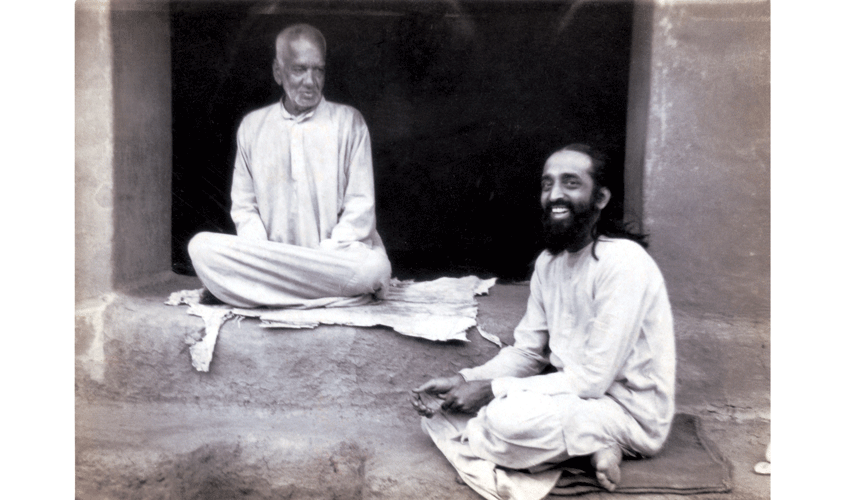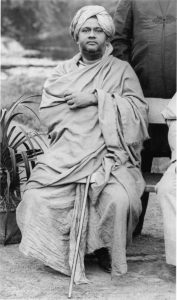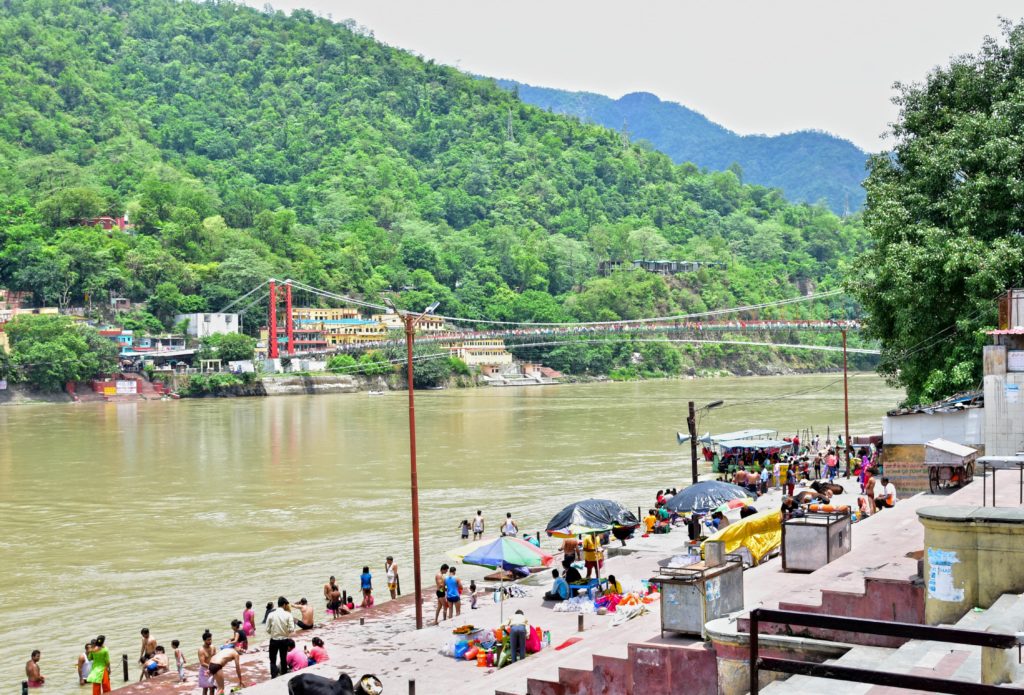Sri Swami Tapovanji Maharaj is one of the most renowned saints of the 19th century. He was a contemporary of Swami Sivananda and guru of Swami Chinmayananda.

Birth and Childhood
Swami Tapovanji Maharaj was born in 1889 on the auspicious Suklapaksha Ekadasi day of Margaseersha month. His mother, Kunchamma, belonged to an ancient aristocratic Nair family in Palghat Taluk of Kerala. His father, Achutan Nair, belonged to Kotuvayur in Kerala. Even as a little boy, Swami Tapovanji Maharaj exhibited a marked partiality for spiritual life. He delighted in worshipping idols fashioned with his own hands. He was admitted to the local English school, but not liking the thoroughly secular education, he decided to quit the school and continued his studies in English, Malayalam and Sanskrit with still greater vigour by himself. Under competent teachers, he mastered poems, dramas, grammar and logic. He read all available religious literature in Malayalam, Tamil, English and Sanskrit. He also engaged in spiritual exercises.
Early Signs
At a very young age and even before donning the ochre robe, he was leading the life of a Sannyasi. He would have an early morning bath, smear sacred ashes and devote all morning to bhajan and studies even without breaking his fast. He was indifferent to worldly pleasures and spent most of the time in deep thought.
Focused on the Path
On his father’s death, Swami Tapovanam (then called Chippukkutty) who was around twenty years of age, became independent. His relatives pressed him to marry, but he did not yield to worldly snares. To visit the Himalayas and spend his life there in study and meditation became his sole objective in life. He once visited Bhavnagar (Kathiawar) and studied under Swami Satyananda Saraswathi. In the short visit itself, he met many learned and holy men.
Since 1912 he stayed on at Palghat and edited a magazine “Gopala Krishna”. This period of his life was full of public activities in other ways too. He was prompted by distinguished friends he delivered speeches on politics, religion, Vedanta, etc. The young men of the time admired him, and even veterans looked up to him with respect. He frequently spoke at public meetings held in big towns like Kozhikode and Tellicherry. He also contributed articles to newspapers. All these literary and oratorical pastimes came to a close before Swamiji reached his twenty-eighth year. Now he ceased to take any interest in them. He visited several holy men like the head of Sri Ramakrishna Mission in Chennai, Sri Mahamahopadhyaya Dandapani Dikshitar, Chatti Swami a great avadhooth and Sri Ramana Maharshi to name a few.
Journey Begins
In 1920 Swamiji was invited by Swami Satyanandaji, who was then the Sankaracharya of Sharada Peetham Dwaraka, to come to Calcutta and spend some time in study and meditation. Swami Tapovanji Maharaj immediately started for Calcutta. During this journey, he met Swami Brahmananda of Sri Ramakrishna Mutt. Then he proceeded to Haridwar and Rishikesh. He returned home via Delhi, Mathura, Brindavan, Pushkar and Dwaraka. These travels completely changed Swamiji’s life. Now all his time was taken up with bhajan, dhyan and study of the shastras. He loved the solitude of the forests and mountains. Swamiji ate only one meal daily and fasted frequently. He spent a few years this way. By then his younger brother had finished his studies, and Swamiji felt that the time had come to fulfil his long-cherished desire. He left his home.

Swamiji proceeded to Panchavati, near Nasik and spent some time there with a Mahatma named Swami Hridayananda. Then he went to the bank of the Narmada and accepted sanyasa. He became a sadhu and mendicant. Proceeding to Prayag and Ayodhya, he passed some time in the company of mahatmas. Later he went to Rishikesh and took up his residence there. Maintaining himself upon alms, he began to practice samadhi. Before long he was initiated formally into sanyasa by Sri Janardanagiri Swami, who was the head of the Kailas Ashram.
Rishikesh and Beyond
He continued to stay at Rishikesh all alone in a hut. In summer he trekked to Uttarkashi and such higher spots in the Himalayas. The account of these travels is found in his book, “Himagiri Vihar” translated as “Wanderings in the Himalayas”. In 1925 and 1930 he visited Kailas and spent some time in the Tibetan lamaseries. A detailed account of these visits may be found in his book, “Kailas Yatra”. In the course of four or five years, Swamiji’s fame spread all around Rishikesh. His spirit of dispassion, sacrifice and thirst for knowledge evoked the admiration of those who came into contact with him. Devotees now flocked to him vying with one another in offering him service. But he hardly made use of their offers. Swamiji who loved solitude made it a habit to leave Rishikesh as soon as the weather improved and go higher up to Uttarkashi. He never descended below Rishikesh even though several wealthy devotees implored him to go down to the plains.

Swamiji’s favourite spots in the Himalayas were Uttarkashi, Gangothri and Badri. Sometimes his sanyasi disciples accompanied him to these places in their eagerness to learn more of Vedanta. Although many had the good fortune to be instructed by him, none had the privilege of being initiated into sanyasa by him.
Books He Wrote
Swamiji wrote several books, both in the days before becoming a sanyasi and after. His first poem was “Vibhakara”. He then wrote “Vishnu Yamakam” as a memorial to his father on his death. At Rishikesh, he wrote translations of the commentaries on Isa, Kena and Katha Upanishads and Sandilya Sutra. He wrote “Himagiri Vihar” and “Kailas Yatra”. In 1929 at Uttarkashi he composed a book of hymns in Sanskrit called “Soumyakaseesa Stotram”. In 1931 at Badri he composed another Sanskrit book, “Sri Badarisa Stotram”. At Gangotri, he wrote several poems in Sanskrit, prominent among them being “Sri Gangotri Kshetra Mahatmyam” and “Sri Ganga Stotra”. To satisfy the eager desire of his devotees, he composed his spiritual autobiography in Sanskrit called “Ishwara Darshana”. Swamiji’s writings are very inspiring, contemplative and reflective of his lofty Vedantic vision.
Samadhi…Not the End
Amid his varied activities, Swamiji’s physical health began to suffer. He told nobody about it. The disciples themselves came to know only when his body was reduced. In spite of his failing health, he strictly continued all his old observances. His disciples wanted to give him medical aid, but he told them that the physical body would have its way. On the auspicious occasion of Magha Pournami in Uttarayana at Brahma Muhurta at Uttarkashi, Swamiji entered into eternal Samadhi. It was February 16th, 1957.
The life and teachings of Sri Swami Tapovanji Maharaj are and will continue to inspire humankind to divinize their lives by turning towards God.
Reference: https://saranaagathi.com/our-teachers/swami-tapovanam/